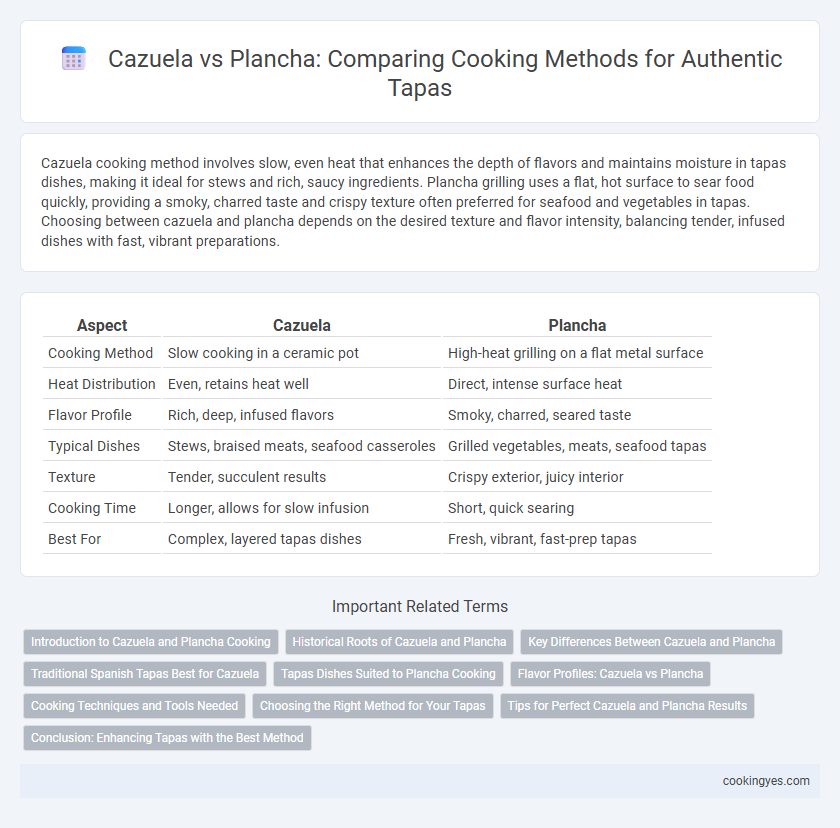Cazuela cooking method involves slow, even heat that enhances the depth of flavors and maintains moisture in tapas dishes, making it ideal for stews and rich, saucy ingredients. Plancha grilling uses a flat, hot surface to sear food quickly, providing a smoky, charred taste and crispy texture often preferred for seafood and vegetables in tapas. Choosing between cazuela and plancha depends on the desired texture and flavor intensity, balancing tender, infused dishes with fast, vibrant preparations.
Table of Comparison
| Aspect | Cazuela | Plancha |
|---|---|---|
| Cooking Method | Slow cooking in a ceramic pot | High-heat grilling on a flat metal surface |
| Heat Distribution | Even, retains heat well | Direct, intense surface heat |
| Flavor Profile | Rich, deep, infused flavors | Smoky, charred, seared taste |
| Typical Dishes | Stews, braised meats, seafood casseroles | Grilled vegetables, meats, seafood tapas |
| Texture | Tender, succulent results | Crispy exterior, juicy interior |
| Cooking Time | Longer, allows for slow infusion | Short, quick searing |
| Best For | Complex, layered tapas dishes | Fresh, vibrant, fast-prep tapas |
Introduction to Cazuela and Plancha Cooking
Cazuela and Plancha are traditional Spanish cooking methods that bring unique flavors to tapas. Cazuela, a clay pot, retains heat evenly, perfect for slow-cooked dishes with rich, melded flavors. Plancha involves a flat metal grill that cooks food quickly at high temperatures, enhancing texture and searing while preserving freshness.
Historical Roots of Cazuela and Plancha
Cazuela, a traditional Spanish earthenware pot, has deep historical roots tracing back to Moorish influences in Iberian cuisine, where its thick ceramic construction allowed slow, even cooking ideal for hearty stews and tapas. Plancha, a flat iron griddle, emerged in the 20th century as a modern Spanish cooking method, prized for its high heat and quick searing, popularized in Basque Country's pintxos culture. Both methods reflect regional culinary evolution, with cazuela emphasizing rustic, slow-cooked flavors and plancha highlighting freshness and texture in tapas preparation.
Key Differences Between Cazuela and Plancha
Cazuela cooking involves simmering ingredients in an earthenware pot, allowing slow heat distribution that enhances flavors and moisture retention, ideal for stews and braised dishes. Plancha cooking uses a flat metal griddle heated to high temperatures, perfect for searing tapas quickly with a crispy exterior and distinct grill marks. The key differences lie in heat application and cooking speed: cazuela offers gentle, even cooking while plancha provides intense, rapid searing for different texture and taste profiles.
Traditional Spanish Tapas Best for Cazuela
Traditional Spanish tapas cooked in a cazuela retain authentic flavors and offer an earthy, rustic presentation that enhances dishes like gambas al ajillo and albondigas. The cazuela's clay material distributes heat evenly, allowing slow cooking that intensifies spices and melds ingredients perfectly. Unlike the high-heat, quick-sear method of a plancha, cazuela cooking is best for richer, simmered tapas that benefit from gradual infusion and moisture retention.
Tapas Dishes Suited to Plancha Cooking
Plancha cooking excels in preparing tapas dishes such as gambas a la plancha (grilled shrimp), pulpo a la plancha (grilled octopus), and chorizo a la plancha, offering a quick sear that locks in flavors and maintains a tender texture. Unlike cazuela, which involves slow cooking in a clay pot enhancing depth and richness, plancha method preserves the fresh, vibrant character of seafood and meats typical in many tapas. This technique is ideal for tapas that benefit from high-heat, fast cooking to achieve a smoky, caramelized exterior while retaining juiciness inside.
Flavor Profiles: Cazuela vs Plancha
Cazuela cooking infuses tapas with deep, rich flavors by slow-simmering ingredients in clay pots, allowing spices and liquids to meld fully. Plancha, using a high-heat metal griddle, sears tapas quickly, preserving fresh, bright tastes and creating a slightly smoky, charred exterior. The choice between cazuela and plancha fundamentally alters the flavor profile, balancing slow-cooked complexity against crisp, intense heat.
Cooking Techniques and Tools Needed
Cazuela cooking involves slow simmering in a traditional clay pot, enhancing flavors through even heat distribution and moisture retention, requiring a ceramic cazuela vessel and a stovetop or open flame. Plancha cooking relies on a flat metal griddle heated to high temperatures, ideal for quick searing and creating a crispy exterior, necessitating a cast iron or steel plancha and high heat source. Both techniques highlight distinct textures and flavor profiles essential in authentic tapas preparation.
Choosing the Right Method for Your Tapas
Choosing between cazuela and plancha for cooking tapas depends on the desired flavor and texture; cazuela, a traditional clay pot, imparts a rich, slow-cooked depth ideal for stews and braised dishes. Plancha, a flat griddle, excels in high-heat searing, delivering a crispy exterior and quick cooking perfect for seafood and vegetables. Understanding these methods enhances your tapas by balancing intense flavors and optimal textures.
Tips for Perfect Cazuela and Plancha Results
Achieving perfect cazuela results requires maintaining moderate, even heat to allow flavors to meld and ingredients to cook thoroughly without burning, while stirring occasionally to prevent sticking. For plancha cooking, preheat the surface until it reaches high temperatures, then sear ingredients quickly to retain moisture and develop a caramelized crust. Use fresh, high-quality ingredients and adjust seasoning after cooking to enhance the authentic flavors of both Spanish tapa styles.
Conclusion: Enhancing Tapas with the Best Method
Choosing between cazuela and plancha for cooking tapas significantly impacts flavor and texture; cazuelas offer slow, even cooking that enhances rich, hearty dishes, while planchas provide high heat for quick searing and crisp finishes. Tapas cooked in cazuelas develop deep, melded flavors ideal for stews and braised items, whereas plancha techniques preserve freshness and deliver a smoky char perfect for seafood and vegetables. Selecting the appropriate method based on the dish's characteristics elevates the overall tapas experience, balancing tradition with vibrant, distinct tastes.
Cazuela vs Plancha for cooking method Infographic

 cookingyes.com
cookingyes.com